technical data SKODA FABIA 2005 1.G / 6Y Owner's Guide
[x] Cancel search | Manufacturer: SKODA, Model Year: 2005, Model line: FABIA, Model: SKODA FABIA 2005 1.G / 6YPages: 260
Page 64 of 260
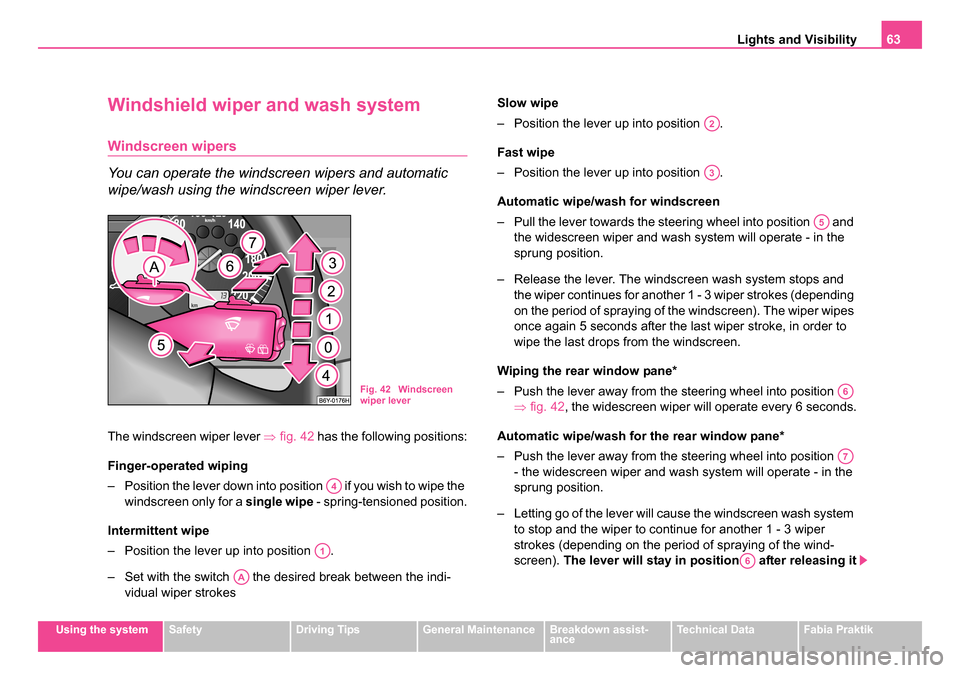
Lights and Visibility63
Using the systemSafetyDriving TipsGeneral MaintenanceBreakdown assist-
anceTechnical DataFabia Praktik
Windshield wiper and wash system
Windscreen wipers
You can operate the windscreen wipers and automatic
wipe/wash using the windscreen wiper lever.
The windscreen wiper lever ⇒fig. 42 has the following positions:
Finger-operated wiping
– Position the lever down into position if you wish to wipe the windscreen only for a single wipe - spring-tensioned position.
Intermittent wipe
– Position the lever up into position .
– Set with the switch the desired break between the indi- vidual wiper strokes Slow wipe
– Position the lever up into position .
Fast wipe
– Position the lever up into position .
Automatic wipe/w
ash for windscreen
– Pull the lever towards the steering wheel into position and the widescreen wiper and wash system will operate - in the
sprung position.
– Release the lever. The windscreen wash system stops and the wiper continues for another 1 - 3 wiper strokes (depending
on the period of spraying of the windscreen). The wiper wipes
once again 5 seconds after the last wiper stroke, in order to
wipe the last drops from the windscreen.
Wiping the rear window pane*
– Push the lever away from the steering wheel into position ⇒fig. 42 , the widescreen wiper will operate every 6 seconds.
Automatic wipe/wash for the rear window pane*
– Push the lever away from the steering wheel into position - the widescreen wiper and wash system will operate - in the
sprung position.
– Letting go of the lever will cause the windscreen wash system to stop and the wiper to continue for another 1 - 3 wiper
strokes (depending on the period of spraying of the wind-
screen). The lever will stay in position after releasing it
Fig. 42 Windscreen
wiper lever
A4
A1
AA
A2
A3
A5
A6
A7
A6
sqc.1.book Seite 63 Mittwoch, 13. April 2005 1:09 13
Page 66 of 260
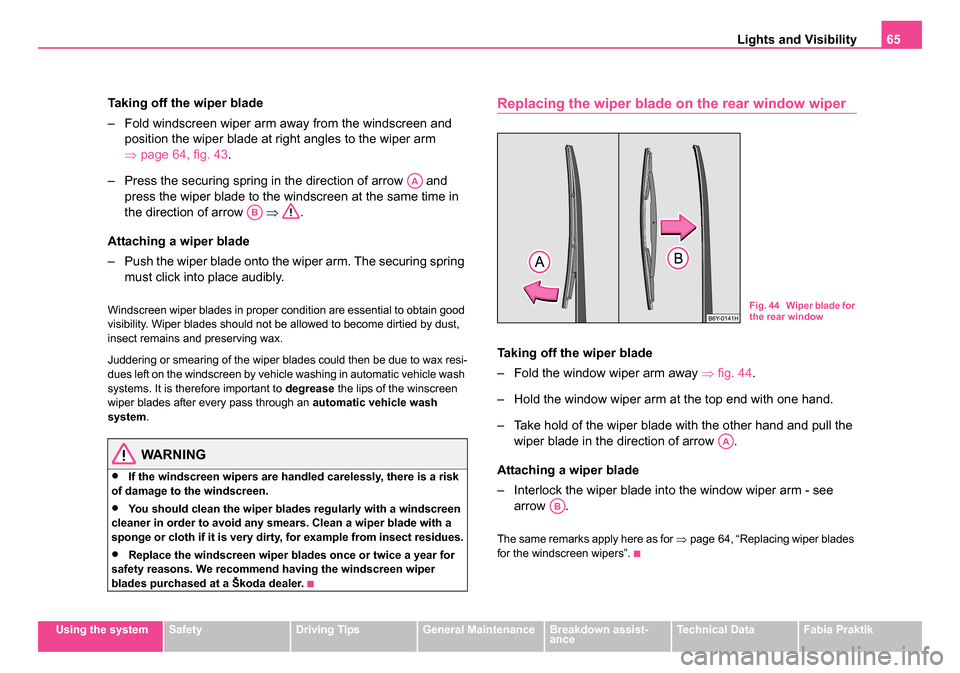
Lights and Visibility65
Using the systemSafetyDriving TipsGeneral MaintenanceBreakdown assist-
anceTechnical DataFabia Praktik
Taking off the wiper blade
– Fold windscreen wiper arm away from the windscreen and
position the wiper blade at right angles to the wiper arm
⇒page 64, fig. 43 .
– Press the securing spring in the direction of arrow and press the wiper blade to the windscreen at the same time in
the direction of arrow ⇒.
Attaching a wiper blade
– Push the wiper blade onto the wiper arm. The securing spring must click into place audibly.
Windscreen wiper blades in proper condition are essential to obtain good
visibility. Wiper blades should not be allowed to become dirtied by dust,
insect remains and preserving wax.
Juddering or smearing of the wiper blades could then be due to wax resi-
dues left on the windscreen by vehicle washing in automatic vehicle wash
systems. It is therefore important to degrease the lips of the winscreen
wiper blades after every pass through an automatic vehicle wash
system .
WARNING
•If the windscreen wipers are handled carelessly, there is a risk
of damage to the windscreen.
•You should clean the wiper blades regularly with a windscreen
cleaner in order to avoid any smears. Clean a wiper blade with a
sponge or cloth if it is very dirty, for example from insect residues.
•Replace the windscreen wiper blades once or twice a year for
safety reasons. We recommend having the windscreen wiper
blades purchased at a Škoda dealer.
Replacing the wiper blade on the rear window wiper
Taking off the wiper blade
– Fold the window wiper arm away ⇒fig. 44 .
– Hold the window wiper arm at the top end with one hand.
– Take hold of the wiper blade with the other hand and pull the wiper blade in the direction of arrow .
Attaching a wiper blade
– Interlock the wiper blade into the window wiper arm - see arrow .
The same remarks apply here as for ⇒page 64, “Replacing wiper blades
for the windscreen wipers”.
AA
AB
Fig. 44 Wiper blade for
the rear window
AA
AB
sqc.1.book Seite 65 Mittwoch, 13. April 2005 1:09 13
Page 68 of 260
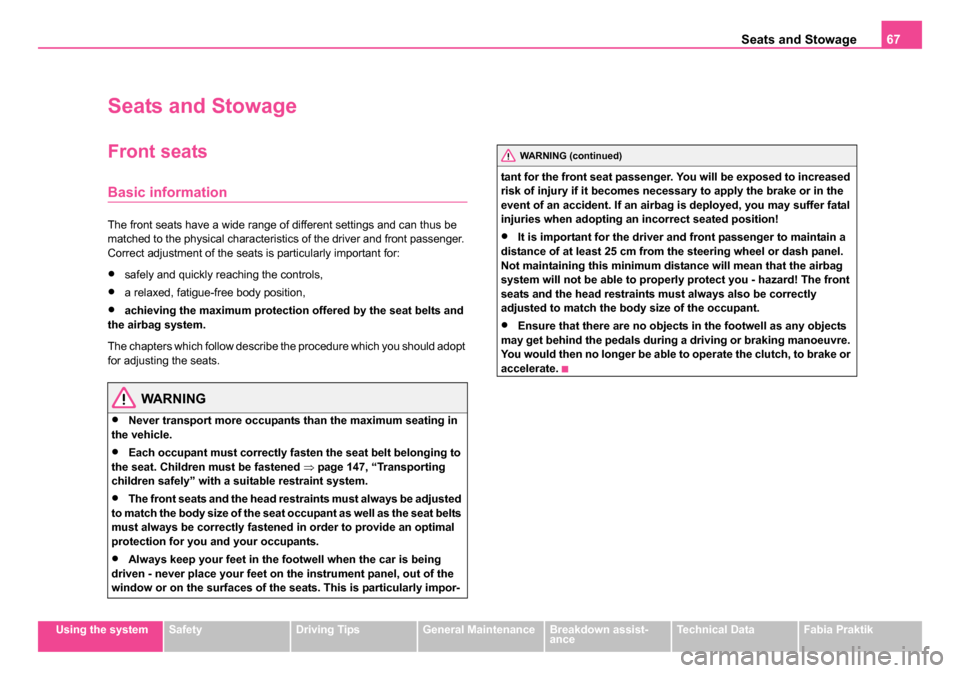
Seats and Stowage67
Using the systemSafetyDriving TipsGeneral MaintenanceBreakdown assist-
anceTechnical DataFabia Praktik
Seats and Stowage
Front seats
Basic information
The front seats have a wide range of different settings and can thus be
matched to the physical characteristics of the driver and front passenger.
Correct adjustment of the seats is particularly important for:
•safely and quickly reaching the controls,
•a relaxed, fatigue-free body position,
•achieving the maximum protection offered by the seat belts and
the airbag system.
The chapters which follow describe the procedure which you should adopt
for adjusting the seats.
WARNING
•Never transport more occupants than the maximum seating in
the vehicle.
•Each occupant must correctly fasten the seat belt belonging to
the seat. Children must be fastened ⇒page 147, “Transporting
children safely” with a suitable restraint system.
•The front seats and the head restraints must always be adjusted
to match the body size of the seat occupant as well as the seat belts
must always be correctly fastened in order to provide an optimal
protection for you and your occupants.
•Always keep your feet in the footwell when the car is being
driven - never place your feet on the instrument panel, out of the
window or on the surfaces of the seats. This is particularly impor- tant for the front seat passenger. You will be exposed to increased
risk of injury if it becomes necessary to apply the brake or in the
event of an accident. If an airbag is deployed, you may suffer fatal
injuries when adopting an incorrect seated position!
•It is important for the driver and front passenger to maintain a
distance of at least 25 cm from the steering wheel or dash panel.
Not maintaining this minimum distance will mean that the airbag
system will not be able to properl y protect you - hazard! The front
seats and the head restraints must always also be correctly
adjusted to match the body size of the occupant.
•Ensure that there are no objects in the footwell as any objects
may get behind the pedals during a driving or braking manoeuvre.
You would then no longer be able to operate the clutch, to brake or
accelerate.
WARNING (continued)
sqc.1.book Seite 67 Mittwoch, 13. April 2005 1:09 13
Page 70 of 260

Seats and Stowage69
Using the systemSafetyDriving TipsGeneral MaintenanceBreakdown assist-
anceTechnical DataFabia Praktik
Head restraintsAdjusting the height of a head restraint
– Grasp the side of the head restraint with both hands and push it up or down in direction of arrow ⇒fig. 47. Best protection
is achieved if the top edge of the head restraint is at the same
level as the upper part of your head ⇒page 125, fig. 103 .
Adjusting the angle of a head restraint*
– The head restraint can be matched to the head of the occu- pant by adjusting the angle in the direction of the arrow
⇒fig. 47 . Adjusting the angle of the head restraint provides
enhanced comfort for the user.
Removing and installing a head restraint
– Pull the head restraint up out of the backrest of the seat as far as the stop (on the rear head restraints fold forward the seat
backrest).
– Press the locking button in the direction of arrow ⇒fig. 48 and
pull the head restraint out.
– To re-insert the head restraint, push it down into the backrest of the seat far enough until you hear the locking button
engage.
The head restraints on the front seats can be adjusted for tipping angle*
and height. The outer head restraints are not adjustable for height. The
middle rear head restraint* is adjustable in two positions ⇒page 70.
The head restraints must be adjusted to match the size of the seat occu-
pant. Correctly adjusted head restraints together with the seat belts offer
effective protection for the occupants ⇒page 125.
Fig. 47 Adjusting head
restraint
Fig. 48 Removing a
head restraint
AA
AB
sqc.1.book Seite 69 Mittwoch, 13. April 2005 1:09 13
Page 72 of 260
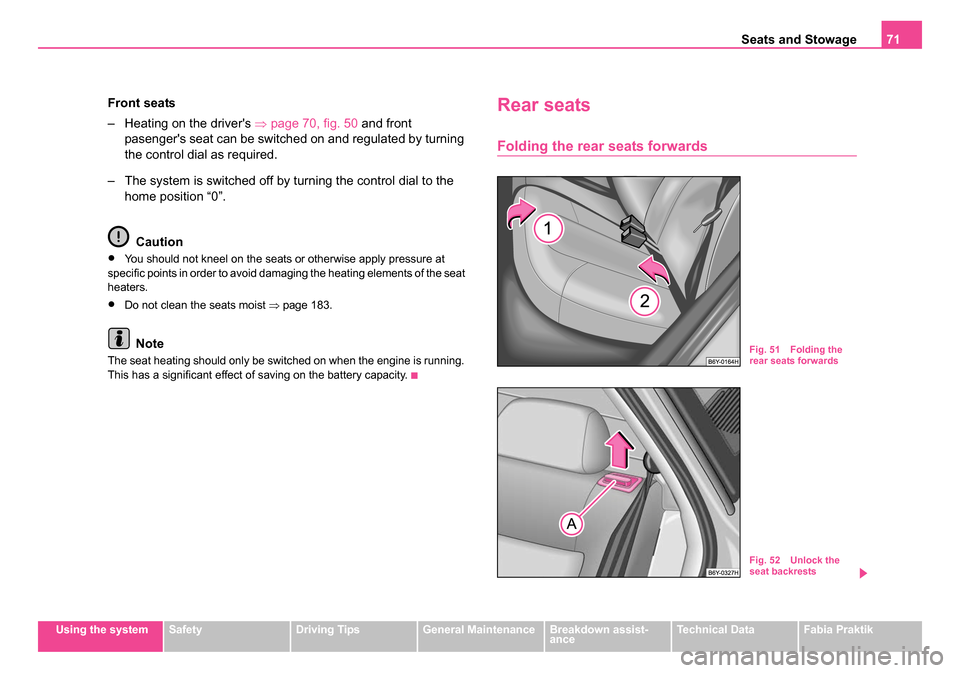
Seats and Stowage71
Using the systemSafetyDriving TipsGeneral MaintenanceBreakdown assist-
anceTechnical DataFabia Praktik
Front seats
– Heating on the driver's ⇒page 70, fig. 50 and front
pasenger's seat can be switched on and regulated by turning
the control dial as required.
– The system is switched off by turning the control dial to the home position “0”.
Caution
•You should not kneel on the seats or otherwise apply pressure at
specific points in order to avoid damaging the heating elements of the seat
heaters.
•Do not clean the seats moist ⇒ page 183.
Note
The seat heating should only be switched on when the engine is running.
This has a significant effect of saving on the battery capacity.
Rear seats
Folding the rear seats forwards
Fig. 51 Folding the
rear seats forwards
Fig. 52 Unlock the
seat backrests
sqc.1.book Seite 71 Mittwoch, 13. April 2005 1:09 13
Page 74 of 260

Seats and Stowage73
Using the systemSafetyDriving TipsGeneral MaintenanceBreakdown assist-
anceTechnical DataFabia Praktik
Inserting head restraints in the rear seats
– The rear head restraints can be inserted into the relevant
holes of the folded forwards rear seats.
Remove the rear seats
The luggage compartment can be increased in size by removing
the rear seats
Removing
– Fold the rear seats forwards completely
– Press the wire clamps in the direction of the arrow ⇒fig. 54
and remove the rear seats from its holder.
Installing
– Press the wire clamp in the direction of the arrow and place the seat upholstery in its holder.
– Fold the rear seats back into its original position.
Fig. 53 Rear seats:
Head restraints in rear
seatsFig. 54 Remove the
rear seats
sqc.1.book Seite 73 Mittwoch, 13. April 2005 1:09 13
Page 76 of 260
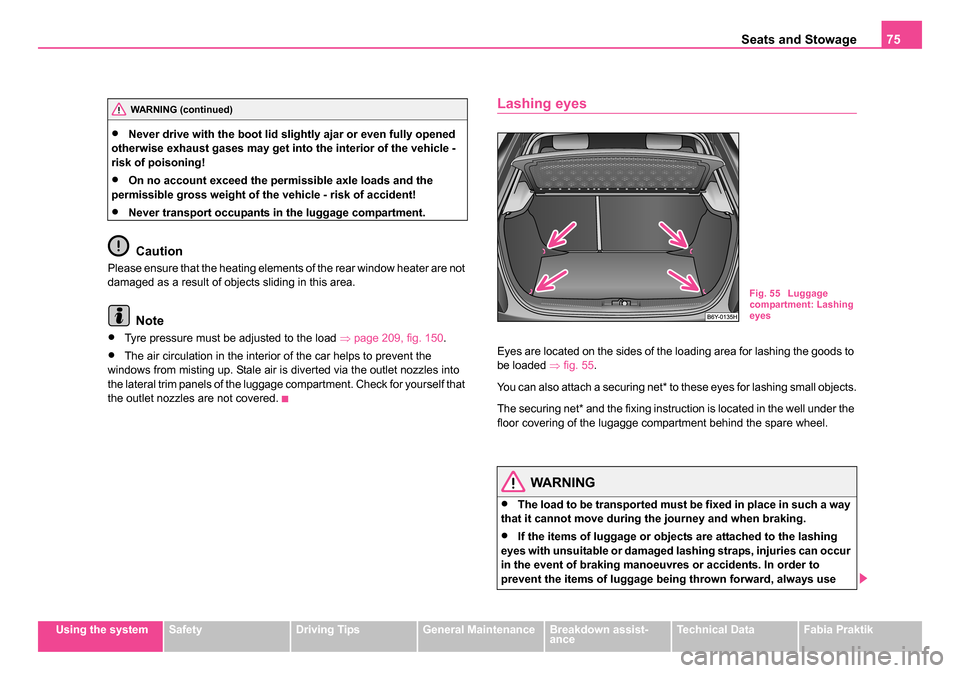
Seats and Stowage75
Using the systemSafetyDriving TipsGeneral MaintenanceBreakdown assist-
anceTechnical DataFabia Praktik
•Never drive with the boot lid slightly ajar or even fully opened
otherwise exhaust gases may get into the interior of the vehicle -
risk of poisoning!
•On no account exceed the permissible axle loads and the
permissible gross weight of the vehicle - risk of accident!
•Never transport occupants in the luggage compartment.
Caution
Please ensure that the heating elements of the rear window heater are not
damaged as a result of objects sliding in this area.
Note
•Tyre pressure must be adjusted to the load ⇒page 209, fig. 150 .
•The air circulation in the interior of the car helps to prevent the
windows from misting up. Stale air is diverted via the outlet nozzles into
the lateral trim panels of the luggage compartment. Check for yourself that
the outlet nozzles are not covered.
Lashing eyes
Eyes are located on the sides of the loading area for lashing the goods to
be loaded ⇒ fig. 55.
You can also attach a securing net* to these eyes for lashing small objects.
The securing net* and the fixing instruction is located in the well under the
floor covering of the lugagge compartment behind the spare wheel.
WARNING
•The load to be transported must be fixed in place in such a way
that it cannot move during the journey and when braking.
•If the items of luggage or objects are attached to the lashing
eyes with unsuitable or damaged lashing straps, injuries can occur
in the event of braking manoeuvres or accidents. In order to
prevent the items of luggage being thrown forward, always use
WARNING (continued)
Fig. 55 Luggage
compartment: Lashing
eyes
sqc.1.book Seite 75 Mittwoch, 13. April 2005 1:09 13
Page 78 of 260

Seats and Stowage77
Using the systemSafetyDriving TipsGeneral MaintenanceBreakdown assist-
anceTechnical DataFabia Praktik
Luggage net*
The luggage net is designed for the tranportation of lighter objects.
WARNING
•In the luggage net you must only store objects (up to a weight
of 1.5 kg). Heavy objects are not secured sufficiently - risk of injury!
•No objects with sharp edges should be stored in the luggage
net, because they can damage the luggage net.
The luggage compartment cover*
You can use the luggage compartment cover behind the
head restraints for storing light and soft items.
The luggage compartment cover can be removed as required if
one must transport bulky goods.
– Unhook the support straps on the tailgate.
– Place the cover on the side supports.
– Pull the cover horizontally to the rear out of the front holders ⇒fig. 59 .
– Install again by pushing it forwards into the holders and hanging the support straps on the tailgate.
Fig. 58 Luggage
compartment: Luggage
net
Fig. 59 Removing the
luggage compartment
cover
sqc.1.book Seite 77 Mittwoch, 13. April 2005 1:09 13
Page 80 of 260

Seats and Stowage79
Using the systemSafetyDriving TipsGeneral MaintenanceBreakdown assist-
anceTechnical DataFabia Praktik
Net partition (Estate)*
Use behind the rear seats
Unrolling
– Fold down the rear seat backrests slightly forwards
⇒page 71, which makes it possible to clear the access for
unrolling the net partition.
– Pull the net partition at the bracket out of the housing in direction of the holders ⇒fig. 61.
– Insert the cross rod into one of the mounts and push the cross rod forward.
– In the same way, fix the cross rod to the other side of the vehicle, mount .
– Then push the seat backrest back into the upright position until the locking button clicks into place - check by pulling on
the rear seat backrest ⇒.
Rolling up
– Pull the cross rod back slightly, first on the one side then on the other side and take the cross rod out of the mount
⇒fig. 62 .
– Hold the cross rod in such a way that the net partition can roll
up slowily and without damage into housing .
If you wish to use the entire luggage compartment, you can remove the
luggage compartment cover ⇒page 78, fig. 60 .
WARNING
•Ensure that the seat backrest on the rear seats is securely inter-
locked in position when the vehicle is fitted with three-point safety
Fig. 61 Unrolling net
partition
Fig. 62 Rolling up net
partition
AAAB
AC
AC
AC
AC
AB
sqc.1.book Seite 79 Mittwoch, 13. April 2005 1:09 13
Page 82 of 260
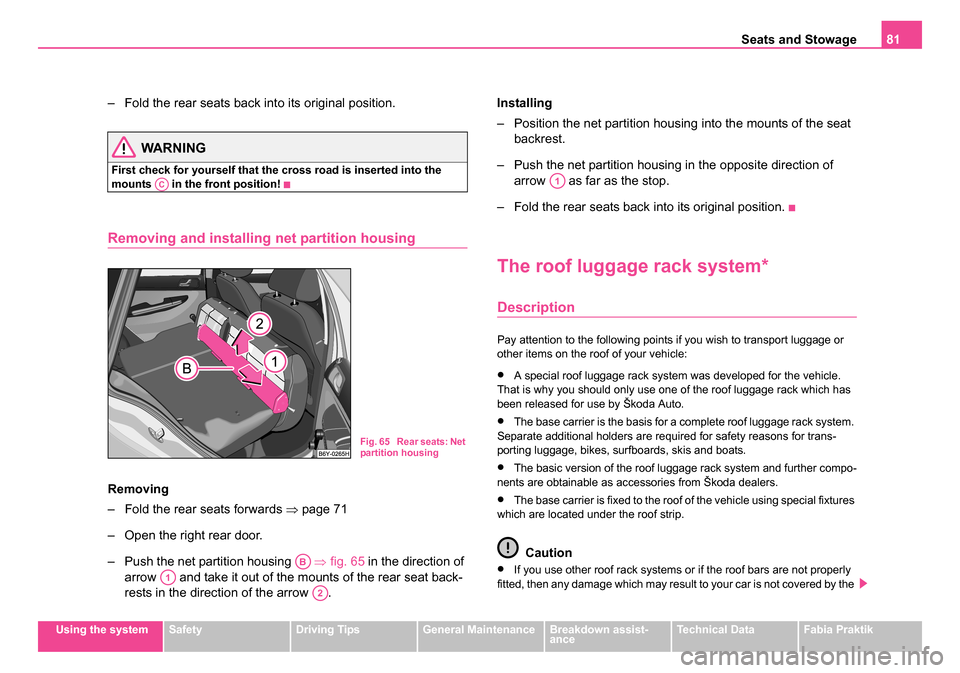
Seats and Stowage81
Using the systemSafetyDriving TipsGeneral MaintenanceBreakdown assist-
anceTechnical DataFabia Praktik
– Fold the rear seats back into its original position.
WARNING
First check for yourself that the cross road is inserted into the
mounts in the front position!
Removing and installing net partition housing
Removing
– Fold the rear seats forwards ⇒page 71
– Open the right rear door.
– Push the net partition housing ⇒fig. 65 in the direction of
arrow and take it out of the mounts of the rear seat back-
rests in the direction of the arrow . Installing
– Position the net partition housing into the mounts of the seat
backrest.
– Push the net partition housing in the opposite direction of arrow as far as the stop.
– Fold the rear seats back into its original position.
The roof luggage rack system*
Description
Pay attention to the following points if you wish to transport luggage or
other items on the roof of your vehicle:
•A special roof luggage rack system was developed for the vehicle.
That is why you should only use one of the roof luggage rack which has
been released for use by Škoda Auto.
•The base carrier is the basis for a complete roof luggage rack system.
Separate additional holders are required for safety reasons for trans-
porting luggage, bikes, surfboards, skis and boats.
•The basic version of the roof luggage rack system and further compo-
nents are obtainable as accessories from Škoda dealers.
•The base carrier is fixed to the roof of the vehicle using special fixtures
which are located under the roof strip.
Caution
•If you use other roof rack systems or if the roof bars are not properly
fitted, then any damage which may result to your car is not covered by the
AC
Fig. 65 Rear seats: Net
partition housing
AB
A1
A2
A1
sqc.1.book Seite 81 Mittwoch, 13. April 2005 1:09 13